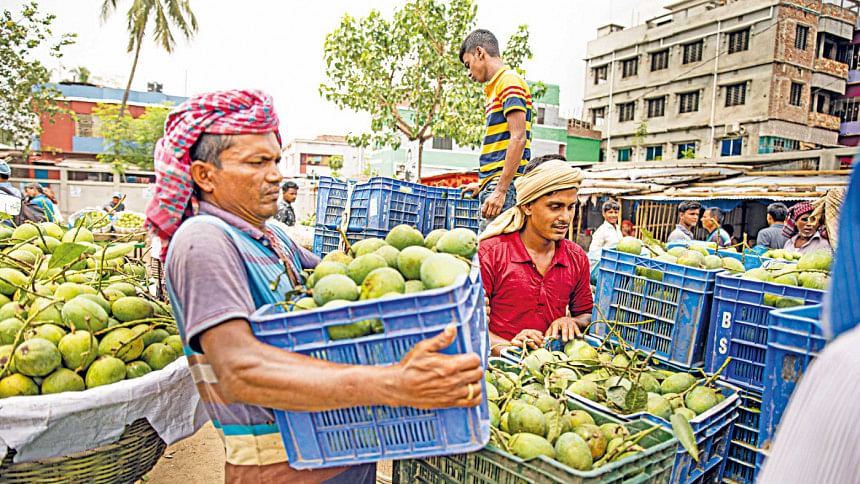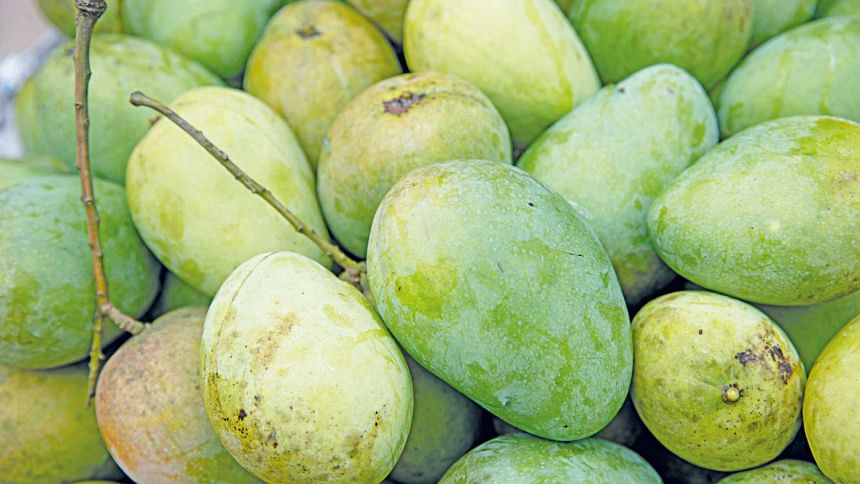Mango bonanza of Kansat wholesale market
During fruit harvesting season, if you are looking for mangoes for consumption or business, Kansat is the ultimate place to be. The Kansat mango market at Chapai Nawabganj is renowned as the largest mango bazaar in Bangladesh and like all bazaars, there's madness here, but there's also distinct method to it.
The Bazaar
Activities start as early as 7AM. The farmers pick mangoes directly from the trees very early in the morning, pack in bamboo baskets or plastic crates and bring them in the bazaar on cycle vans and motor vans.
A continuous stream of vehicles carrying baskets will greet the approaching visitor, and pan out into a large field of the haat, which once was a courtyard of a grand home of a zamindar, now derelict and in ruins.
The main bazaar is an open space that plays host to hundreds of cycle vans carrying baskets of mangoes lined up so densely that it's difficult to walk.
The two baskets balanced on two sides of each cycle easily carry an astounding 200 kg each.

The mangoes come in all shapes and sizes and the sweet aroma of the fruit wafts through the whole market. The farmers here only pick fresh mangoes matured on the bough. As a result, the market turns all shades of green and yellow with dashes of red of ripe mangoes. It is a sight full of promise for any mango connoisseur.
How it goes
Bamboo baskets carry about 100 kgs of mangoes and each crate carries around 20/30 kgs. For each successful sale, the farmers are required to pay a toll, known as 'khajna', at the end of the day — Tk 25 for each basket and Tk 6 for each crate sold.
The selling of mango here is quite a spectacle too. People come here from all over the country and the market hosts the sellers who are both producers and dealers. The transaction begins with inquiries of the mango's origin, or location of the garden. Then comes the bargaining: offers and counter offers and the conversation gets loud and enthusiastic quickly.
People from other cities usually come here in numbers, and each seller usually has a helping hand with them. As a result, a lot of the bargaining become passionate group encounters. Interestingly, the conversation is loud but not heated and every bargaining draws a crowd.

The surroundings
The sea of mangoes is bordered on the sides with warehouses. The warehouses (aarat) play the role of third party between the farmers and businessmen from across the country.
While the market is buzzing with buyers and sellers looking for a good deal, the warehouses are busy with packing and loading the mangoes.
If you watch closely, you will find that often a single mango is sent to the warehouses with a few words scribbled on it. The writings are made with pen and explain details of a mango dealing such as name of the warehouse, selling price and quantity, essentially a receipt. This is an accepted practice around here, along with the fact that one maund comprises of 50 kgs instead of the usual 40.
The mango business
Whether you are looking for Himsagar, Amropali, Fazli, Lengra, Haribhanga or Ashwini mangoes, Kansat bazaar can offer them all. "The star here is Khirshipat aam. It's known as Himsagar in the cities," said Md Sahabuddin, a mango farmer who promises that no other mangoes could compete with Himsagar.
As Kansat is a wholesale market, one has to buy a minimum of 1 maund mangoes if they were to purchase. "Every day I buy at least 40 maunds of mangoes from here and send it to Dhaka, where I have a business. Sometimes the quantity is larger, depending on the demand in Dhaka. I usually end up staying here for the two/three months of mango harvesting. I've been doing this for the past nine years," said one Md Rubel, a wholesale fruit supplier of Dhaka's Malibagh.

"I come here because the mango here is really good, supply is plentiful, and the good quality mango means that my business in Dhaka will be doing well. Every day I do a business of Tk 80-100,000 here," he added.
However, the locals are not happy this year because Kansat bazaar is seeing about half its usual sales. "It's terrible. There's supposed to be atleast twice as many mangoes, twice as many vans and twice as many people. This place becomes so full of mangoes that it becomes difficult to find an empty space to stand, but this year the production is lower than expected. We are missing at least 40 percent in volume," said Md Tia Alam a local mango dealer.
The change in weather and rainfall has affected the production this year and the farmers are suffering because of it. Untimely rain affects the taste, quality and harvesting time of mangoes and if similar weather follows, the Kansat market will lose its appeal in the future.

 For all latest news, follow The Daily Star's Google News channel.
For all latest news, follow The Daily Star's Google News channel. 


Comments